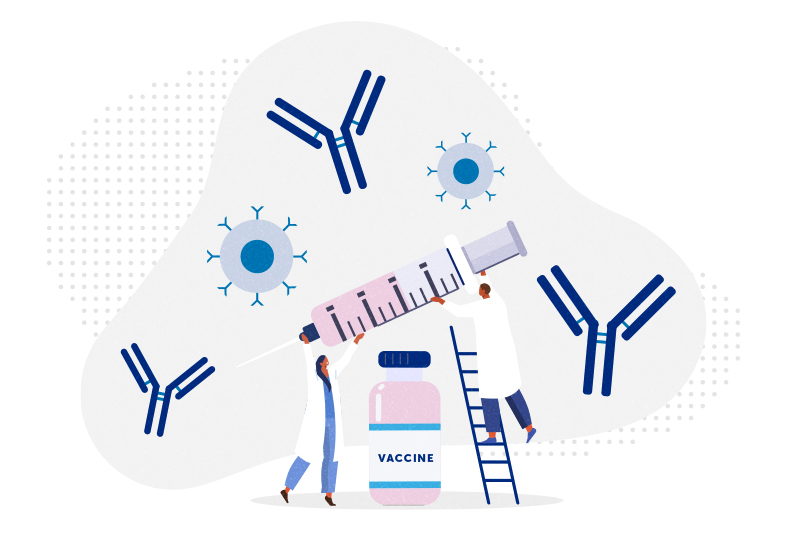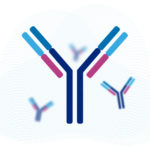Building better antibodies, curbing autoimmunity: New insights on B cells

When we’re vaccinated or exposed to an infection, our B cells spring into action, churning out antibodies that are increasingly potent, specific, and protective. This happens through an iterative process known as affinity maturation.
Two labs at Boston Children’s Hospital have come up with different ways to enhance affinity maturation and help B cells make more broadly protective antibodies — opening a new door to better vaccines and antibody-based biologics.
On the flip side, a third lab shows how B cells and affinity maturation sometimes go awry, creating antibodies that attack the body’s own cells — opening a door to new treatments for autoimmune disease.
Honing antibodies for vaccines and biologics
Previous lab-based approaches to creating more potent antibodies have fallen short, leading to disruption of B cells’ function or the creation of antibodies that are inefficient and unstable. Researchers led by Yiming Yin, PhD, in the lab of Michael Farzan, PhD, in Boston Children’s Division of Infectious Diseases, set out to capture the natural power of affinity maturation. As described in Nature Biomedical Engineering on March 14, they performed CRISPR gene editing on B cells in mice, replacing genes for antibody light and heavy chains with their human counterparts at their appropriate chromosomal locations.
“Our goal is to harness underlying wisdom of our own immune system,” Farzan says. “Humans have very specific immune features that animal models don’t mimic.”
The animals’ B cells then underwent affinity maturation, producing potent human antibodies in a short amount of time. As a proof of concept, Farzan, Yin, and colleagues introduced the genomes for HIV antibodies into mouse B cells. They then exposed the cells to a test HIV vaccine and allowed affinity maturation to happen. This generated new and better antibodies against HIV — something they next hope to try in primates. In another test, they got mouse B cells to shift from making antibodies against early strains of SARS-CoV-2 to making antibodies able to neutralize Omicron variants.
An adjuvant to charge up flu vaccines?
In separate work, Pankaj Sharma and colleagues in the lab of Florian Winau, MD, in the Program in Cellular and Molecular Medicine (PCMM), focused on germinal centers, the structures in our lymph nodes and spleen that facilitate B cell maturation. They found that a lipid called Gb3 is needed for B cells to mature in the germinal center and make high-affinity antibodies.
“This lipid also increases the diversity of B cell responses, leading to the generation of broadly neutralizing antibodies,” says Winau.
When the researchers added Gb3 to a flu vaccine, the vaccine protected against diverse strains of influenza — a virus that tends to mutate and elude vaccines. They propose that Gb3 be used as an adjuvant for vaccination — potentially for a variety of viral infections. They are also now testing Gb3 as an adjuvant for anti-cancer vaccines. Findings were published in Science on February 16.
New insights on autoimmunity: How B cells go rogue
Two more studies explored how B cells sometimes go overboard, producing antibodies that attack a person’s own tissues. Led by Elliot Hideki Akama-Garren in the PCMM lab of Michael Carroll, PhD, the first of these focused on follicular T cells, which provide signals to help B cells in the germinal center with the process of affinity maturation.
The team found that a specific set of follicular T cells can go rogue, leading to the formation of B cells that lose their “tolerance” to the body’s tissues and produce auto-reactive antibodies. The findings may have treatment implications for autoimmune conditions like lupus and rheumatoid arthritis, as well as the development of auto-reactive antibodies in people with Epstein-Barr virus or COVID-19. Findings were published February 16 in Science Immunology.
Making B cells auto-reactive
A companion study from Carroll’s lab, led by Theo van den Broek, MD, PhD, and Kristine Oleinika, PhD, and published March 22 in Science Immunology, further investigated how autoimmune disease is initiated. It started with the knowledge that B cells that have lost tolerance to the body’s own tissues can take hold in germinal centers, which in turn become auto-reactive. In people with early or low-level autoimmune disease, naive B cells — not yet exposed to a vaccine or pathogen — enter these germinal centers and then go rogue as well, producing a wide range of auto-reactive antibodies.
Carroll and colleagues wanted to understand what enables this to happen. By joining the blood circulations of wild-type mice and mice with lupus, they could observe the development of autoimmunity in real time. They identified several ingredients that enable healthy B cells to invade auto-reactive germinal centers: Toll-like receptor 7, B cell receptor specificity, antigen presentation, and type 1 interferon signaling.
While more work is needed, Carroll believes the insights from these two studies could lead to new targets for treating autoimmunity.
“These latest observations will allow us to break down the kinetics of how new clones of autoreactive B cells become activated and how disease ‘spreads’ to new tissue targets, which is a major problem in diseases such as lupus,” he says.
Learn more about research at PCMM and the Division of Infectious Diseases.
Related Posts :
-

Nanobodies from alpacas could steer immune attacks on influenza
While conventional flu vaccines are designed to anticipate the influenza strains projected to dominate in the next flu season, they’...
-

Diversifying therapeutic antibodies: From one, come many with potential different uses
A new method for producing antibodies against disease could result in a wider variety of drugs for infectious diseases, immune ...
-

Exposing a tumor's antigens to enhance immunotherapy
Successful immunotherapy for cancer involves activating a person’s own T cells to attack the tumor. But some tumors have ...
-

Tim Springer: Scientist, entrepreneur, and mentor
As an undergraduate in 1966, immunologist, biochemist, and biophysicist Timothy A. Springer, PhD, looked askance at science. The Vietnam War was ...





